Ready to design and build your own speaker crossover? You’re in the right place!
Here’s a very easy-to-use speaker crossover calculator along with great info to help you.
Note: Javascript must be enabled in your browser to see or use the tool.
Contents
SPEAKER CROSSOVER CALCULATOR
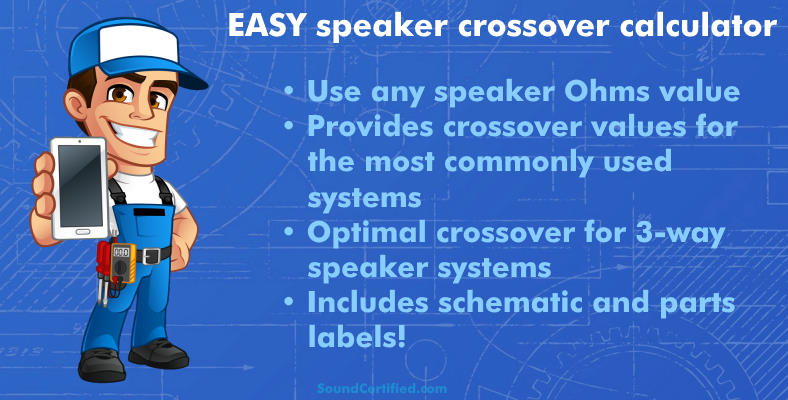
You can use my speaker crossover calculator to generate parts values to build your own capacitor, experiment with different values, and more.
How to use the calculator
- Select the crossover type:
- 4 types are available: 2-way 2nd order Linkwitz-Riley (12dB/octave), high or low-pass 1st order Butterworth (6dB/octave), 1st order 2-way Butterworth (6dB/oct.), and 1st & 2nd order 3-way crossovers.
- A speaker crossover schematic matching the type you chose will be shown.
- Enter the speaker impedance (Ohms) as needed. This can be whole numbers, fractions, or both. (Ex.: 4 ohms, 3.6 ohms, etc.)
- Enter the crossover frequency desired. For 3-way crossovers, enter the bandpass upper (tweeter/midrange) and lower (midrange/woofer) cutoff frequencies. (*See my notes below regarding 3-way crossovers below.)
The calculator will output capacitor and inductor part values as needed. Parts are labeled to match the the example schematic shown for each type you select.
Reversing out of phase speakers for even-order designs
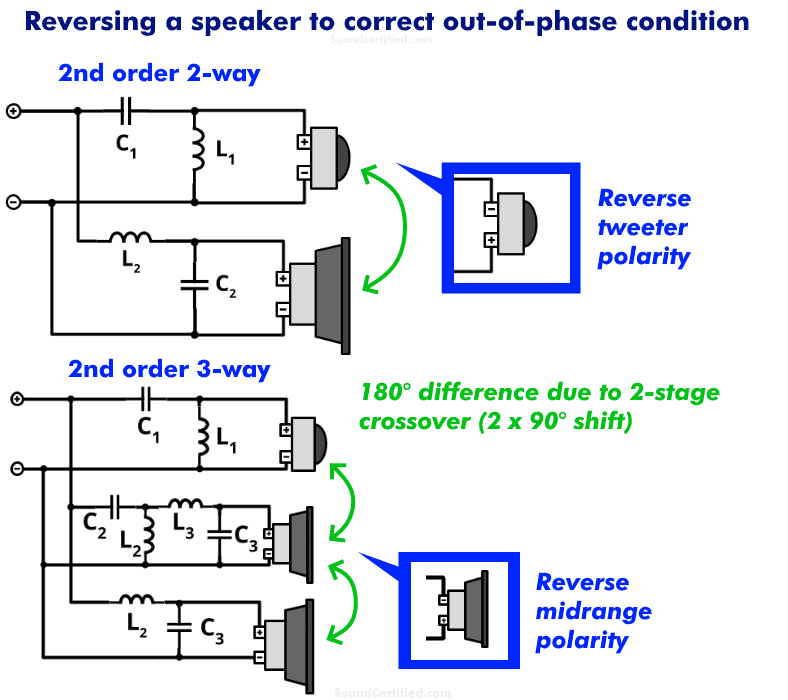
When building a speaker crossover and using a 2nd order or other even-order designs, it’s important to remember to reverse one speaker driver to correct the 180 degree out of phase condition.
Crossover capacitors and inductors each add a 90° phase difference, giving 2nd order crossovers a 180° out of phase condition that will affect the sound.
An out of phase condition can result in destructive interference (sound wave cancellation) in the overlapping range of sound between two speakers (three speakers in the case of a 3-way system) near the crossover frequency. It will also sound “weird” because the timing of the audio waves you hear conflicts.
For example, you can hear the same effect if two speakers are placed near each other with one having its speaker wiring reversed. In that case, you may notice poor bass until one speaker is disconnected due to cancellation.
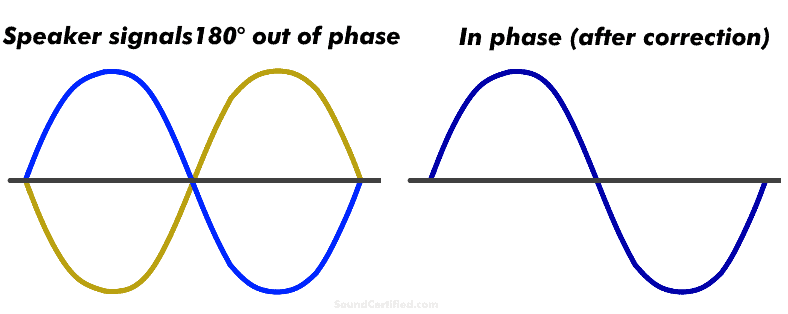
Image showing 180 degree out of phase audio waves and the resulting in-phase (0° difference) condition after reversing the speaker.
Fortunately, there’s an easy fix:
- For 2-way crossovers, reverse the tweeter connection polarity.
- For 3-way crossovers, reverse the bandpass speaker (midrange speaker) polarity.
You can do this by reversing the wiring at the speaker terminals in the crossover building stage or reversing the connection polarity label once it’s completed.
This is almost never a problem for ready-made crossovers you buy as this is usually already taken into account when they’re designed.
Why use a Linkwitz-Riley crossover for 2-way crossovers?
Linkwitz-Riley designs are hands-down one of the most commonly used for a number of reasons, one of which is their flat response where the woofer and tweeter crossover points overlap. While it’s true that plenty of other designs exist (Butterworth, Chebychev, Bessel, and others) they do not offer the same frequency response.
They certainly have useful applications but the Linkwitz-Riley (L-R) crossover is generally a great choice for standard speaker systems with a -12dB per octave slope.
The flat magnitude response, low sensitivity to offset, and in-band driver resonances have made the L-R a popular choice among manufacturers.Vance Dickason, The Loudspeaker Design Cookbook (7th ed.)
It’s also not sensitive to speaker driver resonance like some others. If you’re interested in the technical aspects of the different crossover designs available, I’d encourage you to read more.
I highly recommend Vance Dickason’s The Loudspeaker Design Cookbook for more detailed information as it shows examples and covers the topic in good detail. You’ll also learn tons of other speaker design info!
3-way crossover details for the calculator
To get the best results (3-way crossovers are NOT simply an extension of 2-way designs), the calculator uses a 3-way all pass crossover (APC) design with a sufficient frequency range between the high pass frequency and the low pass frequency.
You can also use a general rule based on the ratio of the high pass cutoff (Fh) and low pass cutoff (Fl):
Some great example 3 way frequencies to use are:
- 3kHz/375Hz
- 5kHz/625Hz
- 6kHz/750Hz
Or, simply pick the upper frequency and divide by 8 to get the 2nd. Likewise, you can pick a lower frequency and multiply by 8 to get a good upper frequency.
However, do be aware that 3-way designs have a midrange output with a higher or lower dB level – in this case, the 3-way design provided has a 2.45 dB gain vs the tweeter and woofer. (This is a pretty minor difference however)
Crosspoints closer together than the three-octave ideal will suffer from complicated undesirable interference patterns.Vance Dickason
Consider adding a Zobel network and series notch filter
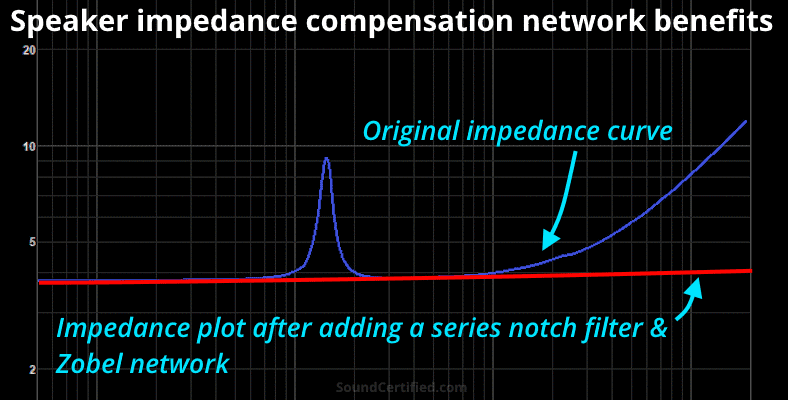
Want even better results from your speaker system? Consider adding a Zobel impedance compensation network and in the case of midrange & tweeter drivers a series notch filter. Those will tame nasty impedance issues:
- The steep impedance rise at higher frequencies due to voice coil inductance.
- Very high (peak) Ohms at the resonant frequency “Fs.”
I cover all this on my Zobel network and series notch filter calculator page.
How precise do crossover capacitor and inductor part values need to be?
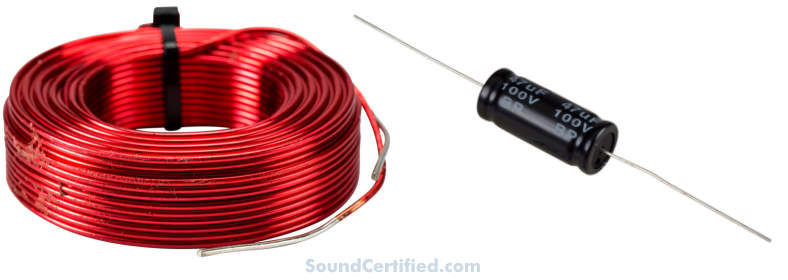 I recommend trying to get fairly close to the calculated parts values; exact values are not practical or needed. For example, if the calculator recommends a 10.56mH (milliHenry) inductor, you’d try to get close to 10.5 mH, not 10.56mH. If you found a 10.2mH for example, that would usually be close enough.
I recommend trying to get fairly close to the calculated parts values; exact values are not practical or needed. For example, if the calculator recommends a 10.56mH (milliHenry) inductor, you’d try to get close to 10.5 mH, not 10.56mH. If you found a 10.2mH for example, that would usually be close enough.
Similarly, for the parts themselves, standard tolerance parts are fine for most designs. You don’t need to spend additional money on better tolerance components.
Of course, that doesn’t mean you shouldn’t use better quality or higher performance parts if you’d like – just that for most cases standard (20% – 15% tolerance) is fine.
Typical inductor and capacitor tolerances
The truth is that picking super-precise part values is kind of useless anyway because the components have as much as a 20% tolerance. For example, a 4.7 µF (4.7 microFarad) non-polarized capacitor, 20% tolerance, could have an actual capacitance as low or high as:
- Low end: 3.76 µf
- High end: 5.64 µF
As you can see, trying to pick the perfect parts values doesn’t make sense because they won’t be exactly that value anyway. That’s out of your control. Just try to get it pretty close if possible.
Most inductors are similar as well – especially air core wire wound inductors.
Affordable ways to get better sound performance
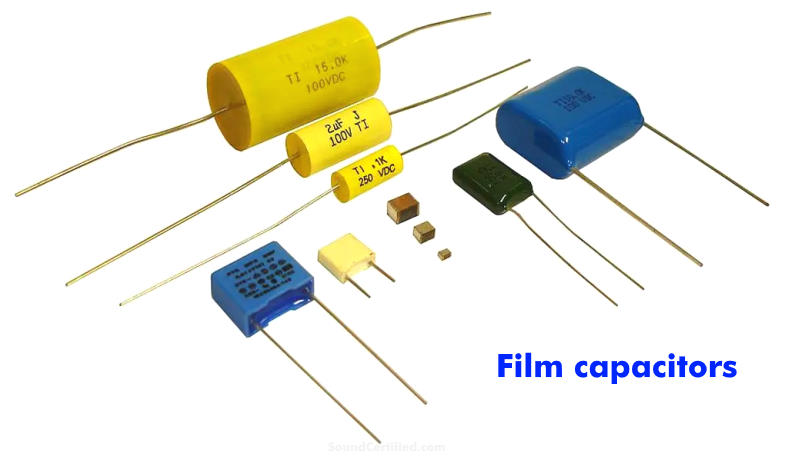
Electrolytic capacitors are extremely common in speaker crossovers and filters..but did you know? There’s another little-known way to get better sound and better parts quality without spending a lot: polypropylene, polyester, and film capacitors.
They offer some nice benefits for only a little bit more money:
- Longer life/don’t leak over time like electrolytic capacitors
- Higher voltage handling (great for vacuum tube designs!)
- Better audio performance (better for carrying the audio signal)
- Vertical solder leads may make them easier to use in printed circuit boards or DIY projects
- Some film capacitors are more compact than their counterparts
Film capacitors are generally bipolar (non-polarized) so they’re great for audio designs, but it’s important to always check the specs to be sure.
Also, be sure to verify their voltage rating – you’ll want a rating that’s at least equal to or higher than your amp or stereo’s output voltage generally.
Inductor options
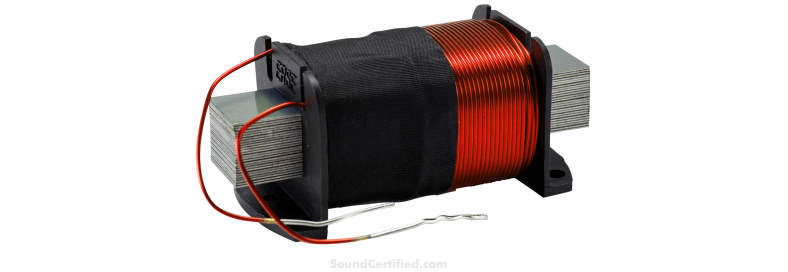
They’re not mandatory, but you can also consider using iron core or metal-core inductors. These types have a more dense magnetic field characteristic, meaning they can be a bit smaller than air core models in some cases.
What voltage audio capacitors do I need?
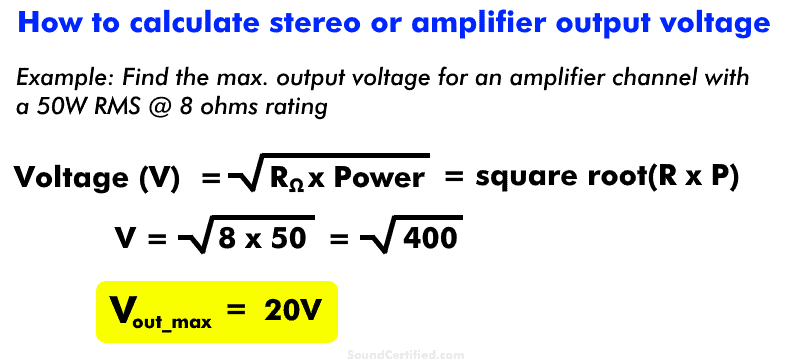
There’s an easy way to find the voltage rating for audio capacitors in crossovers: you can find the approximate stereo amplifier or radio output voltage if you know the power per channel (RMS or continuous) and speaker Ohms.
Simply use this formula: Volts = square root(Speaker Ohms x Max. Continuous/RMS Power)
This will give you the approximate voltage at maximum output power. Once you know that, I recommend using capacitors with a voltage rating at least the same, if not higher, voltage rating.
Otherwise, for standard power levels (not using maximum power out), you can use the next closest value.
Off-the-shelf bipolar capacitors sold for audio applications are normally of a sufficient working voltage. Still, it pays to check. Lower voltage bipolar parts (5V, 16V, etc.) are usually used for low-voltage (line level) electronics.
TIP: adjusting the crossover frequency to match parts on hand
Here’s a helpful tip I’ve picked up after building my own crossovers. If you’ve got parts on hand you’d like to use you might be able to do so by slightly changing the crossover frequency.
For example, let’s say you use the calculator for a 2-way 2nd order design at 3,000Hz, 4Ω:
- C1, C2 = 6.63uF
- L1, L2 = 0.42mH
Let’s also say you have some capacitors on hand that are below 6uF. By changing the crossover frequency slightly, you can sometimes use parts you already have.
Obviously this won’t always work, and not all speakers are suited for it, but it’s a helpful strategy in some cases. Using a calculator, you can play around with values in seconds and see what works.
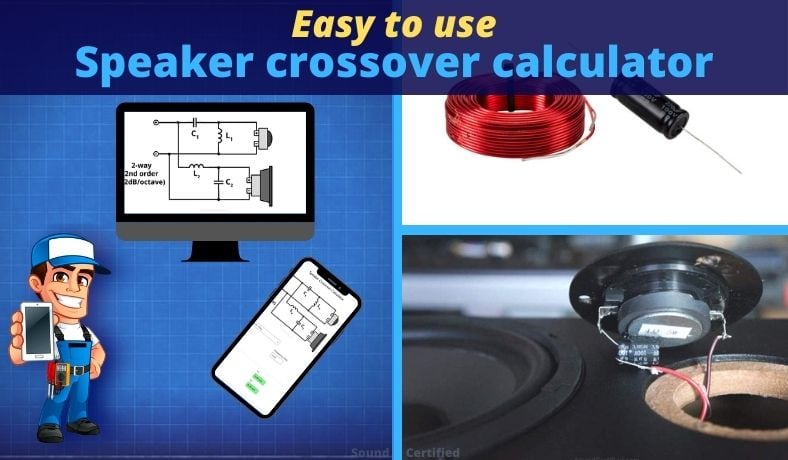

Question… let’s say I’m building a 3-way speaker. The tweeter is 8ohms, the mid is 4ohms and the woofer is 8ohms. What do I do to ensure the output is a specific rating (in my case, ideally 6 or 8ohms)? Is this just a matter of wiring the speakers in series or parallel, or is there another component that I can use in the crossover to enforce it?
Thank you in advance. This article is great!
Hello TJ. In this case, to ensure you keep an 8 Ohm load, you could:
1. Add a second 4Ω midrange in series with the first.
2. Add a 4Ω power resistor in series with the midrange.
Option #1 is a bit more ideal, as option #2 means 1/2 the midrange power will be wasted as heat across the resistor. If your amplifier or receiver needs a minimum 6Ω load, then using the 8 Ohm load will be fine. (If that is what you meant).
Best regards!
Thanks Marty!
I was more curious than anything else. I wasn’t exactly sure what approach would be better but your explanation makes perfect sense. I’d rather use the power than have it being wasted on heating up the resistor. In this specific case I would probably run the two 8ohms in parallel (drop to 4ohms) and then connect them in series with the 4ohm mid to bring it back to a consistent 8ohm load.
I am a woodworker and have been a bit of an audiophile for most of my life, so I’ve decided to build my first pair of speakers from scratch. I have some beautiful wood and several different drivers to work with so it’s time to get the whole crossover thing down. Your articles are very helpful. Advanced enough for someone who isn’t quite a beginner (I do have some engineering in my background) without getting too technical. I’m sure I’ll be back once I start testing out the speakers to look more in to Zobel network.
Until then…
I have the klipsch rp450c, it has 1x horn tweeter and 4x 5.25 woofers its a 2.5way design. Can I build or order a new crosser over for a 3 way design using the same amount of speakers?
[link..]/klipsch-rp-450c-review/ link has the details on the center speaker.
Hello, Jay. You can do that, just you’ll need to wire the woofers according to their Ohms rating.
For example, with 4 woofers, some solutions are:
• 8Ω woofers: wire sets of two in series (16Ω), then those in parallel. 16Ω || 16Ω = 8Ω total.
• 2Ω woofers: wire in series for 8Ω total.
You could do this for a 2-way design or add a midrange for a 3-way design, either way. Best regards.
Welcome!
I would like to ask if I use several bass speakers in a mixed circuit so that the resulting resistance matches the impedance of one speaker.
In this case, do I substitute the value of the resulting resistance in the calculator?
Thanks
István Krischneider
Hello there. Yes, you would use the total Ohms load you would like to build a crossover for when calculating part values.
That’s because the crossover’s behavior will be affected by the *total* Ohms load the capacitor, inductor, or capacitor-inductor pair “sees” connected to it.
Best regards!
Working on restoring an older jukebox with woofer and midrange speakers (the midrange have to cover highest frequencies also). The original wiring includes only an induction coil in parallel across the midrange speaker inputs, and a capacitor in parallel across the woofer inputs. This doesn’t seem to match what you are showing here, and I’m wondering if there is some explanation for what the original wiring used? Is it worth redoing the wiring to match the 2-way crossover you show? (I have new speakers to use).
Thanks!
Hi Larry. Yes, that’s pretty unusual. To clarify crossovers a bit:
• A capacitor acts as a high-pass when connected in series to a speaker, but a parallel inductor will work similarly.
• An inductor acts as a low-pass when connected in series to a speaker, but a parallel capacitor will work similarly.
There is probably a bit more to the design that you & I don’t see. We don’t normally use paralleled components like that because below their crossover frequencies, the inductor or capacitor act more like a shorted connection.
By any chance are the woofer & midrange speaker setups all wired in series? If not, there is likely something else in line with the speaker wiring.
Either way, technically speaking, if your new speakers are the same impedance, there should not be a problem if you simply swap them for the originals. If you have access to a wiring diagram for the original amplifier that might help show if there’s anything else in the design.
Best regards!
Thank you Marty,
I can’t post a copy here (or don’t know how) but the wiring diagram in the manual shows exactly what I describe, just a capacitor (“33MFD NP”) in parallel across each woofer, and an inductor coil (mH not specified) across the midranges. There are also drawings of the internals of the amplifier and such, but they don’t show anything resembling full or parts of crossover wiring. So maybe this is just how they implemented simple high and low pass filters? It’s a jukebox, they probably weren’t deeply concerned about sound fidelity from the 45’s. I’m thinking maybe I will just retrofit proper 2nd order crossovers per your design spec as I get a chance, it will be pretty easy to modify what’s there.
Best regards and thanks for the info on this site, it is great!
Hi Larry, if you need to reach out directly my email info is on my Contact page (see the menu at the top).
It’s a little difficult to say what their intention was, but there’s usually a reason for something unusual like that. But yes, high fidelity probably wasn’t considered important as you said.
Thanks for your kind words it is appreciated. :)
Also just one more observation, the wiring diagram does show that the L woofer is connected with the negative wire to the + terminal, opposite of the right woofer which is + to +, and both midrange are wired + to + .
Well one more and sorry for my confusion. So these are actually wired with the woofer and midrange in series on each side. So on right, the positive signal goes to the + on right woofer. The – on right woofer goes to + on R midrange, and – on R midrange goes to common ground in amp.
The left positive signal goes to the – on the L woofer, and the + on L woofer goes to + on L midrange and – on L midrange to common. The diagram is kinda old and faded, took me a bit to decipher it but this is how the diagram shows and wires match this.
Ok, yes it sounds like they just used an alternative wiring configuration but which still works as a simple 2-way setup. You should still be able to swap it out for a standard 2-way crossover setup if you like, however.
So assuming I just replace the existing speakers and add parallel wiring and proper crossovers, what is your advice about using coax midrange/tweeter speakers (which would fit better)? They typically come with a capacitor built in as a high pass filter for the tweeter part, but no inductor. So it wouldn’t match the design of the 3-way crossover wiring. So do you advise adding in the proper inductor to the tweeter in a crossover? Might also imply use of a different capacitor value.
Thanks!
Hi Larry. **Please ignore my previous reply if you saw one – I misread your question & deleted it to correct my reply.**
Ah ok, that’s a clever idea you have. :)
If you know the tweeter’s capacitor’s capacitance value, yep you could do this, actually. To make the tweeter’s crossover into a 2nd order one (like in 2-way or 3-way setups), you’d only have to connect an inductor 1) to any point between the capacitor and the tweeter, and 2) to the negative speaker terminal/negative speaker wire side.
Yep, if it seems like a headache figuring out the capacitance value, it might be easier to just replace the original capacitor and not deal with it. You can even just cut the wiring between the original capacitor and the tweeter, then add your own as you like.
It’s not always easy to do on coaxials because of how they’re made sometimes, so if you shop around you should be able to find some where the tweeter wiring it more accessible, making it less of a challenge.
Best regards.